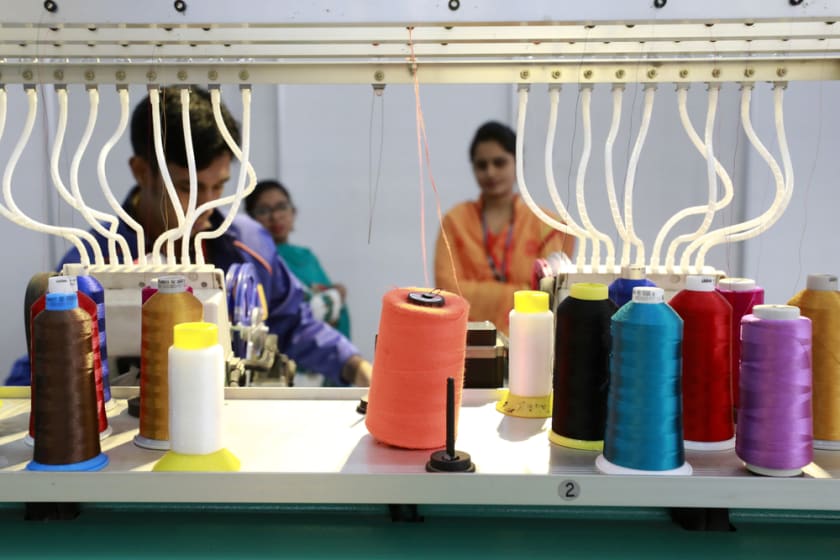Budget FY23 and Its Impact on Textile and Apparel Exporters



As COVID-19 starts to clear out this year, factories and businesses have started work at full capacity, and India’s economy looks hopeful for an optimistic fiscal year! However, the union budget FY 23 has rolled out many changes! From digital currency to a higher outlay of infrastructure, bigger government capital expenditure, lesser taxes for major cooperatives and adequate support for small scale industries, this year‘s budget features many elements which will bring a huge change to the growth of the Indian economy.
The finance minister of India has sketched a 35.4% hike in the capital expenditure plan of the central government, to a whopping 7.5,00,00,00,00,000 (7.5 lakh crore), for the fiscal year 23!
Moreover, the budget has also announced various measures to cope with the capital expenditure of the states as well. Now, the states will be able to get up to 1,00,00,00,00,000 (1 lakh crore) through the scheme as financial assistance for capital investment. This is almost 7 times more than last year’s 15,000 crores. This is over and above normal loans, as the states get an interest-free scheme that has a 50-year tenure.
The budget has also introduced AMT or alternative minimum tax for cooperative societies of 15%, from the earlier 18.5%, providing a better year for private entities. The sub-charge has also been reduced to 7% from the previous 12% for businesses with income between 1 and 10 crore! All these changes will have a huge impact on the farming communities, rural societies and even the textile and apparel business.
Budget Allocation for the Textile Sector
In this fiscal budget, 12,382.14 crores have been allotted especially to the textile sector. This is about 8.1% higher than the previous year’s budget, which was 11,449.32 crore. Even with the hike in the budget, no fund is specifically allotted to the PPS or power loom promotion scheme. Earlier in 2021 to 2022, the budget allocation was 3631.64 crores, which was revised in the later period to 11,449.32 crore, due to the hike in the recruitment of cotton, by the CCI under the price support scheme. This was initially 136 crores, which was then hiked to 8439.88 crores. For this financial year, about 9243.09 crores have been allocated, which is almost 9.5% higher than the revised budget the last year.
133.83 crore is allocated by the government in the present budget for the textile cluster development scheme, making the total budget for the research in capacity building to be hiked by 73.4%. This reaches up to 478.83 crores for this fiscal year and is much more compared to the allocation of 276.10 crores from the previous year. The funds for the North East textile promotion scheme have been omitted by the government for this year, even though it was allocated 49.94 crores the previous year. The production linked incentive and the PM mega integrated textile region and apparel scheme, which was recently introduced, were also allocated a budget of 15 crores each.
A budget of 105 crores has also been allotted by the government to the raw material supply scheme for the year 2022–2026.
How the Textile and Apparel Exporters Will Benefit from Budget FY23? An Extraction from the Budget FY23
The finance minister of India, Nirmala Sitharaman, specifically opposed various schemes that impact the textile industry.
MSME
The e-Shram, Aseem, NCD, and Udyam portals are to be interlinked. The scope of these portals is to be widened, as they will act as organic databases and provide live results while providing B2C, B2B and G2C services. The services will play a huge impact on skilling, credit facilitation, recruitment, etc., by enhancing the economy as well as creating opportunities to enable new businesses.
Moreover, around 130 lakh small, medium and micro enterprises receive additional credit under the emergency credit line guarantee scheme. The scheme has also helped many businesses mitigate harm from the impact of the COVID-19 pandemic. Given that various micro and small scale enterprises have a long way to go before they regain pre-pandemic business levels, the ECLGS is to be extended till March 2023. The guarantee cover is also to be expanded from 50,000 crores to 5 lakh crores!
The credit guarantee trust for micro and small enterprises scheme is also a part of the revised budget. This year’s budget allocated an additional credit of 2 lakh crore, especially for micro and small scale enterprises, thus expanding employment opportunities.
The rising and accelerating MSME performance programme has a budget of 6000 spread over a span of five years. All these schemes are sure to help the MSME sector to become more competitive, efficient and resilient.
Special Economic Zones
Along with the various reforms proposed for special economic zones, the budget also undertakes reforms in the SEZ custom administration. This ensures that special economic zones are fully driven by IT and function under the national customs portal. This change is to be implemented by September 30 this year and will ease the business of the special economic zone units in a good way.
Export Promotion
In this fiscal year, the special economic zones act is also to be replaced by a brand new legislation that will allow the states to become partners in the development of enterprise and service hubs. This new act will cover new industrial enclaves and the large existing ones, in order to optimally use the infrastructure available, while enhancing the flow of exports.
Capital Goods & Project Imports

The 2016 national capital goods policy aims to double the production of capital goods by the year 2025. This would result in increased economic activity by creating a lot of employment opportunities. However, several duty-free imports have been guaranteed to some capital goods over the past three decades, in sectors like fertiliser, power, textile, footwear, leather and food processing. These are some of the exceptions that have brought down the growth of the domestic capital goods sector.
Keeping this in mind, the government has decided to phase out a few rates in the project imports and capital goods by imposing a tariff of 7.5%. There are a few exceptions. For instance, the importing of advanced manufacturing missionaries that are not manufactured within the country shall still be in order.
Exports
In order to incentivise the export, a few exemptions are provided for a few items like trimmings, zippers, buttons, specified leather, lining material, packaging boxes and furniture fittings that are needed by exporters that handle leather garments, handicrafts, textiles and leather footwear.
Tariff Simplification & Review of Customs Exemptions
Over the last two fiscal years, the budget has rationalised various customs exemptions. The government has once again carried out an impressive consultation by crowdsourcing, which resulted in more than 350 entries to be phased out gradually. These exemptions include entities like industries that produce chemicals, medical devices, fabrics, medicines and drugs! As a method of simplification, several concessional rates are further being added to the customs tariff schedule.

Many such schemes and implementations in this year‘s budget have delighted the apparel and textile industry. This year’s budget mainly focuses on growth and investment in infrastructure. These changes are likely to result in more employment opportunities as well as investment in export while easing out the procedures for various industries. The central government will have a capital expenditure of Rs.10.68 crores for the year 2022–2023, which is about 4.1% of the total GDP. This ensures overall growth of the economy and acceleration in spite of any disruptions like a fourth wave or intermittent lockdown.
Conclusion
The various schemes and renewed budgets for this fiscal year by the finance minister of India, Nirmala Sitharaman, have more or less created a good impact on the textile and apparel exporters and industry. With the renewed policies, the growth rate of the businesses in the country is expected to go up by an additional 9.27% in the upcoming year, making it a phenomenal achievement for the country after the great strike of the pandemic. This phenomenal growth might double the textile business size over the next five years.
For more insight about the textile and apparel business, check out our blogs on Fashinza! Fashinza is a one-stop destination for everything fashion and textile! The platform tends to provide you with end to end protection management, from the design, costing, and quality checks to the delivery, making your clothing business a hassle-free experience.



















